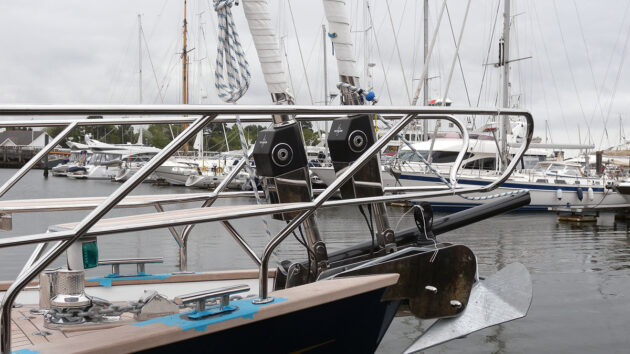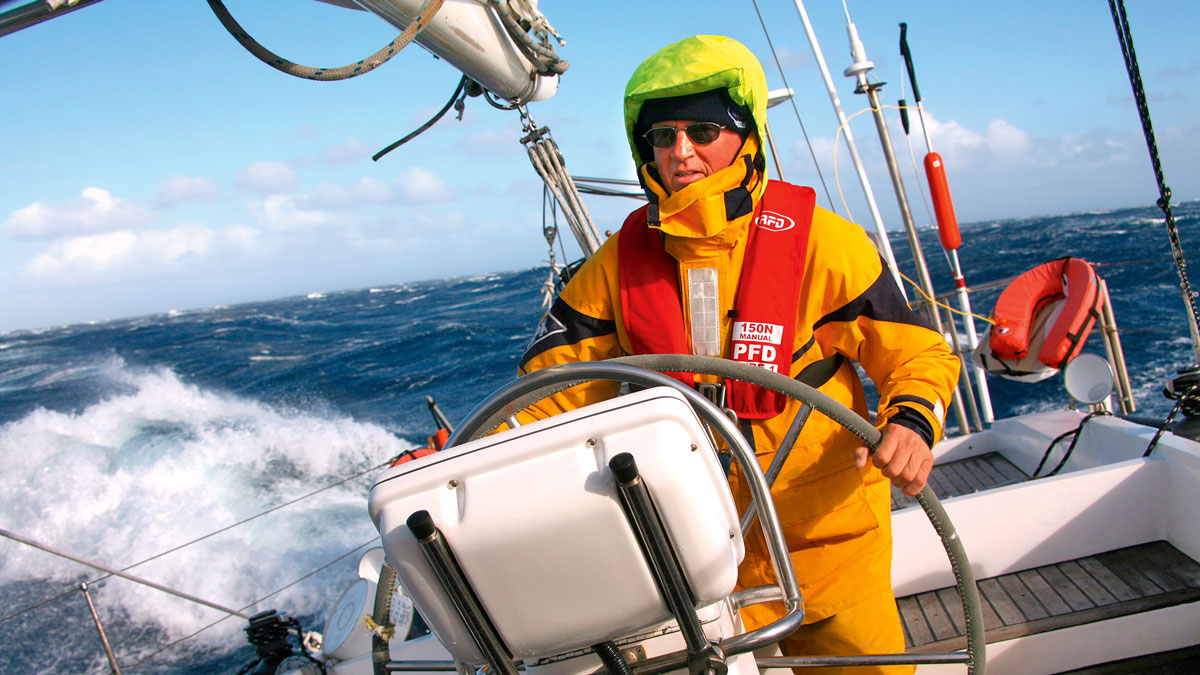With a plethora of furlers on the market, Stan Cockeram weighs up a number of factors to help you decide which is best for your boat
Roller furling systems are now nearly ubiquitous on cruising yachts of all sizes and have been seen on many racing yachts, writes Stan Cockeram.
They have changed the way we sail immeasurably. This article looks at roller furling systems that can reef the sail, having a foil into which the sail is inserted so that when the foil is rotated, the working area of the sail is effectively reduced or increased.

Good lead – This shows the way the single block is placed to give a nice perpendicular entry into the drum
There are a multitude of different furlers in the marketplace, each having its own features and benefits which will lead you to the best choice for you.
Once you have bought and installed the furler, there are some other considerations to be looked at so that you can get the best from your investment.
Roller furling systems: The furling line
Starting first with the furling line, all manual reefing furlers use either a single line or a continuous line.
The advantage of a continuous line is that the amount of rope is minimised but the single line is much easier to positively make off using a cleat or a clutch, and this has become by far the most common solution.

Poor lead – This shows how an excellent furler can be let down by a less-than-perfect installation
The most important aspect of the furling line is that it should be led correctly into the furling drum: in virtually all cases, this should be at 90° to the forestay so that the line can take up evenly within the drum.
Failure to address this issue will end up with line piling up at one of the drum, causing jams or worse if the line manages to fall out of the drum.
Some manufacturers add a lead to the furling unit to guide the line, but a small block in exactly the right place will serve at least as well, sometimes better.
Back to the cockpit
In most cases, the furling line needs to be guided back to the cockpit. This can be arranged in several ways using either blocks or fairleads (usually bullseye).
Whichever approach is taken, there are a few things to consider.
The fewer deflections the line takes, the less friction there will be in the system – if you are using more than two or three leads, it is probably best that you use good-quality ball-bearing blocks to ensure the least resistance.

Roller furling: The furling line is led aft on the inside of the stanchions using good-quality blocks
The leads should be arranged to provide the minimum trip hazard – some manufacturers make very effective leads to guide the line outside the stanchions, which will provide the best protection in this respect.
The last block on the furling line should be a ratchet block to give good control of the line, especially when unfurling the sail.
How often does the order to unfurl half the sail result in the whole sail pulling the furling line out of the hand of the unfortunate person trying to control it?
A ratchet block will give control. Some people use a winch to provide friction for the same reason, but this limits the angle that the line can be guided from and obviously stops the winch from being used for anything else.

The furling line is led aft on the outside of the stanchions, reducing encroachment onto the side deck and removing the trip hazard
The furling line can be held by a figure-eight cleat, cam cleat or a clutch. You should choose which based on the size of your boat and the anticipated load on the line.
Finally, on the subject of furling lines, the actual rope to be used should be given consideration.
A rope that doesn’t stretch will give more consistency to the reefed size of the sail. A Dyneema line stops the sail getting bigger as you grind it in!
Roller furling systems: Sails
Moving on to the actual sail, often when installing a furler for the first time the sailor will wish to continue to use his existing sail/s.
This can be done, but often leads to a less-than-satisfactory result.
The best furling sails are made specifically for the purpose – they will have a straighter luff and have less fullness so that they reef into a good shape for sailing in more breeze and a higher clew to reduce the extent to which the sheet lead needs to be moved when reefing.
Another significant factor is the quality of the cloth – once the head and tack patches are wound onto the furler, a good quality, stable cloth will help the sail hold its shape.

Roller furling: This shows how the sacrificial UV strip is applied to the sail and also shows the calibration marks
Converting a typical 150% genoa to be a furling sail will require the luff to be cut down in length, the hanks removed and the luff reshaped before the new luff tape is applied, and will still result in a sail that is too full when reefed and which needs big changes to the sheet lead when changing sail sizes.
Never say never, but it might be time to get a new reefing headsail made for the purpose…
Additions to the sail that are specific to the requirements of a furling headsail include a sacrificial strip to protect the sailcloth from UV when the sail is left up for the whole season and bulking of the luff of the sail to improve the reefed shape.

Roller furling: The luff of the sail is given more bulk selectively in order that the sail is flattened as it is wound around the stay
This works by making the roll fatter where the sail has the most shape and pulls that extra shape flat as you reef.
This is most often achieved by adding rope or foam to the luff just behind the luff tape.
This works well with independent head and tack swivels that feature on many furlers to help flatten the reefed sail – just make sure the luff tape is cut back enough to allow the swivels to do their work.
Reefing
And so we move on to actually using the sail. Too often people reef their jib without moving the car, resulting in poor performance and increased wear to the leech of the sail, not to mention a horrible racket!
Sail trim is a dark art, but there are some simple principles that will keep us close to optimum. Set up your sail in an appropriate breeze for the unreefed area and make sure you know where that lead is!

Roller furling: This drawing demonstrates how the lead moves when the sail is reefed, meaning that adjustment is essential
If your sail has calibration marks, then reef to the first mark and adjust the lead until the sail is right – this is made much easier by having telltales on the jib at appropriate points for each reef.
Get all the telltales to fly together and the sheet lead will be close to correct.
Then reef to the next calibration mark and repeat the process. You should then have a good starting point for the sheet lead at each reefing position.
Moving the cars
This, of course, does not address the issue of how to move the cars to the correct lead points.
If you can tack then you can set the car in the right place before the tack, reef the sail during the tack and then move the new lazy car.
If you can’t tack then someone is going to have to go down into the wet bit and move the car.
The sheet will need to be depowered while this happens, either by luffing, easing or furling the sail. I prefer the latter if possible.
The car is then moved and, using the ratchet block for control, the sail unfurled to the correct calibration mark and sheeted.
Marks on the line that correspond to the calibration mark will also help.
A better solution for moving the cars is available in the form of towing cars. These are similar to mainsheet traveller cars in that they move on some form of bearing system (usually recirculating ball bearings).
It is worth noting at this point that it is impossible to tow a car on T Track when the sheet is loaded.
You can set up a system to move the car so that you don’t have to leave the cockpit, but you will need to unload the sheet using one of the previously mentioned methods.
Towable genoa cars
The problem with towable genoa cars if you don’t already have suitable tracks is that there is usually significant investment involved in changing the tracks and cars.
If you are prepared to make that investment, reefing will never be the same!

If you have towable genoa cars, you can set them up to move when you reef
You can then set up the cars to move when you reef – have marks to move the car to which correspond to the calibration marks.
The load on the towing lines is quite significant (40-60% of the sheet load in some cases), so suitable purchases and means to secure the lines will need to be provided.
If you have towable genoa cars, you can set them up to move when you reef
Problems with furling rolling systems
Problems with furlers are often caused by installation issues (not following the instructions, too many or too big deflections in the furling line, not having a good lead into the drum), but one serious issue that can cause damage to the furler or even risk the rig is the risk of halyard wrap.
This occurs when there is too much free halyard at the top of the sail.
This means that the top swivel does not turn when the foil does and the halyard wraps itself around the foil, preventing any further movement.
The halyard can then cut into the foil or put stress on the forestay and its attachment.
Obviously, we wish to avoid this, so what can we do? Firstly, your sailmaker can make the foresail luff length such that the halyard swivel is as close as is practicable to the halyard top block or sheave: this shortens the free length of halyard and prevents wrap.
Keep the halyard under tension – nothing excessive, but again, enough to prevent the halyard wrapping – and don’t pull the halyard on so tightly that the forestay goes slack.
Sail too short
If the luff is too short, a pennant could be added between the head of the sail and the swivel, moving the swivel up so that wraps are eliminated.
To establish how long a pennant is required, unfasten the tack of the sail and hoist it so that the swivel is in the right place, then measure from the tack of the sail to the tack shackle on the furler – this will give you the length of pennant required.

This shows how a pennant at the top of the sail will move the halyard swivel up to the point where a halyard wrap is unlikely
Most sailmakers recognise the need for the swivel to be near the top of the forestay at all times and will build the sail so that large variations in luff tension are not required.
Putting very high tension on the halyard introduces excessive loads to the bearing system in the hub of the furler and will cause friction or even damage.
If none of the above works and you still get halyard wraps, you will need to look at the physical deflection of the halyard (using a halyard deflector or similar) to ensure things don’t go wrong.
This should be a last resort as it adds friction and prevents the use of the halyard for most other purposes.

This shows how a halyard deflector changes the angle of the halyard to make a halyard impossible
Additionally, if you do have excessive resistance when you try to furl or reef the sail, do not resort to using a winch to wind the fuller (except in the case of very large yachts where the furler is designed to be used this way).
Reduce friction in the furling line, ease the sheet more quickly as you furl and make sure that there is sufficient rig tension that the luff is not sagging away too much, making the foil very difficult to turn.
As we said at the outset, the reefing furling system has changed the way we sail: using a few techniques and a little care in setting up will make the fuller much easier to use, giving better sail trim and boat performance.
In-mast roller furling problems: how to rebuild a Seldén furling gearbox
Mark Ryan rebuilds his Seldén furling gearbox after wrestling with stiff roller furling for a year and discovers stress-free and…
Headsail furling: how to choose the right system
There is a huge range of headsail furling gear on the market. Rupert Holmes gives some tips for choosing the…
Practical ideas from the Ocean Globe Race yacht Galiana WithSecure
Katy Stickland finds clever design features which can be adapted for cruising yachts while sailing the Swan 55, Galiana WithSecure
Heavy weather sailing techniques: how to protect your boat in storm conditions
Øyvind Bordal and Magne Klann explain the steps you need to take to protect your rig and sails when the…
Want to read more articles like How to choose the right roller furling system for your boat?

A subscription to Practical Boat Owner magazine costs around 40% less than the cover price.
Print and digital editions are available through Magazines Direct – where you can also find the latest deals.
PBO is packed with information to help you get the most from boat ownership – whether sail or power.
-
-
-
- Take your DIY skills to the next level with trusted advice on boat maintenance and repairs
- Impartial in-depth gear reviews
- Practical cruising tips for making the most of your time afloat
-
-
Follow us on Facebook, Instagram, TikTok and Twitter








